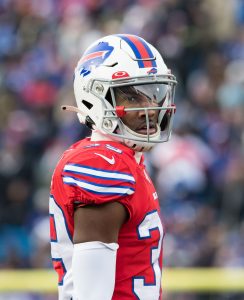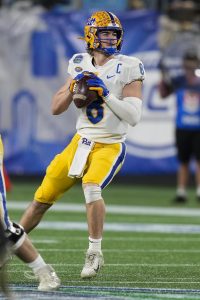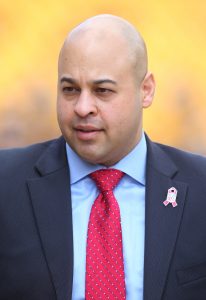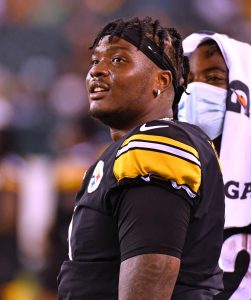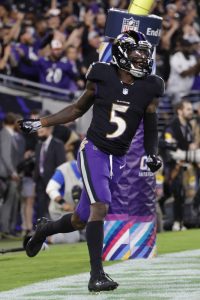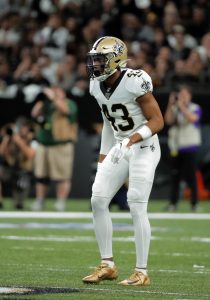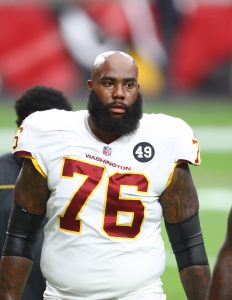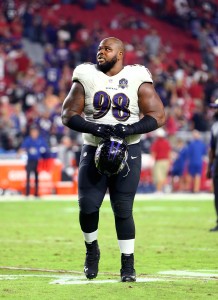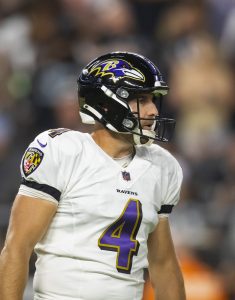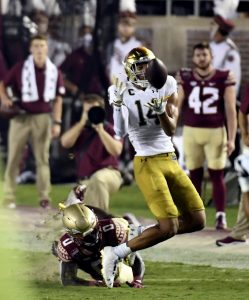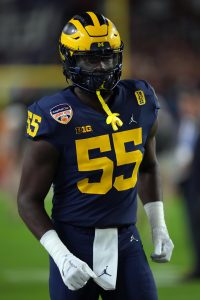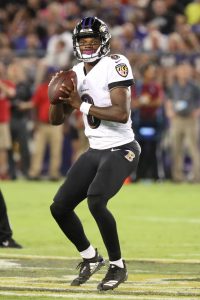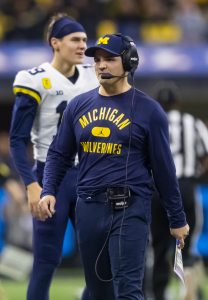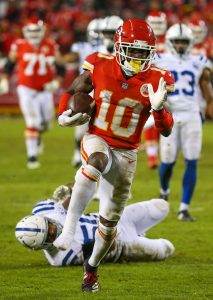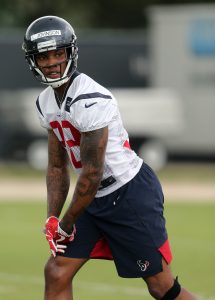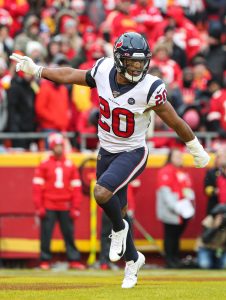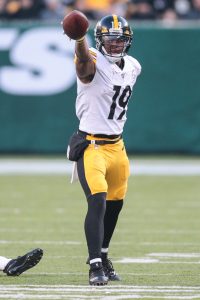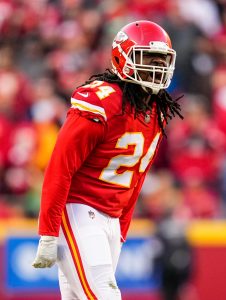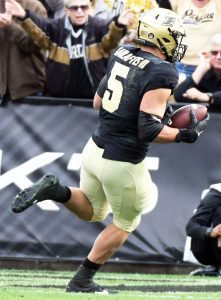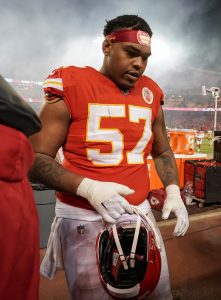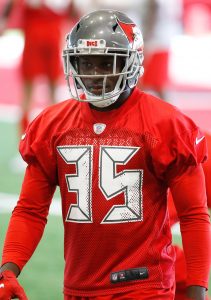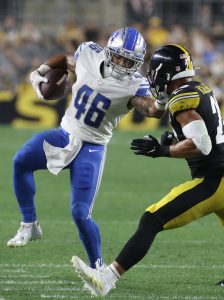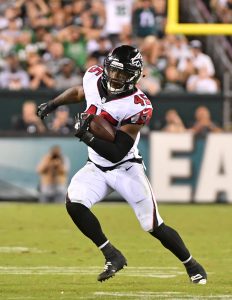Following a busy offseason in 2021, the Patriots stayed relatively quiet in 2022. In the long run, it probably doesn’t matter much. No matter what moves the team could have possibly made this spring, the success of the 2022 Patriots was always going to be dependent on the progression of Mac Jones.
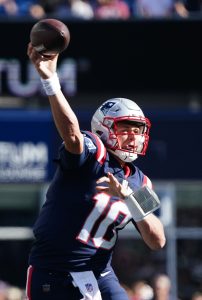 The 15th overall pick in last year’s draft may have been the fifth QB off the board, but he was the only rookie quarterback to make the playoffs and earn a Pro Bowl nod during the 2021 campaign. Still, there’s plenty of room for improvement, and the Patriots’ best chances at another Super Bowl will depend on Jones’ ability to break into at least the top 10 at his position.
The 15th overall pick in last year’s draft may have been the fifth QB off the board, but he was the only rookie quarterback to make the playoffs and earn a Pro Bowl nod during the 2021 campaign. Still, there’s plenty of room for improvement, and the Patriots’ best chances at another Super Bowl will depend on Jones’ ability to break into at least the top 10 at his position.
Still, following a quiet offseason, the major question in New England is if the Patriots have put Jones in the best position to succeed. Sure, the team has invested plenty in receiver and tight end (including the acquisition of DeVante Parker this offseason). However, following an offseason where division rivals surrounded their young QBs with a first-team All-Pro (Tyreek Hill) and a first-round pick (Garrett Wilson), the Patriots receiving corps certainly looks to be underwhelming.
Further, with Josh McDaniels taking the head coaching job with the Raiders, the Patriots are without an offensive coordinator…and they’re relying on a pair of unconventional options to fill the coaching void.
Ultimately, the Patriots are hoping for internal progression from the squad. Bill Belichick always looms as a threat, but thanks to New England’s offseason moves (or lack thereof), that progression might not be seen in the wins column.
Trades:
Despite adding four notable pass catchers during the 2021 offseason (WR Nelson Agholor, WR Kendrick Bourne, TE Hunter Henry, TE Jonnu Smith), there was still an expectation that the Patriot would bring in another target for Jones. In typical fashion, the Patriots ended up ignoring the big-name trade options and pivoted to a division rival’s former first-round pick.
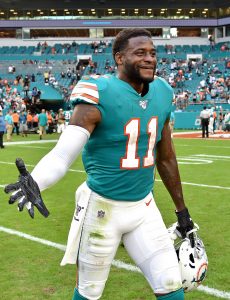 Parker didn’t live up to his first-round billing during his time with the Dolphins. His impression 2019 campaign (72 receptions, 1,202 yards, nine touchdowns) proved to be an outlier. Over the past two seasons, Parker had collected a combined 103 receptions for 1,308 yard and six touchdowns in 24 games. The drop in production could be partly attributed to offensive coaching changes, injuries, and a revolving door at starting QB, but there’s also a reason why the Dolphins have invested so much draft capital into the position over the past two offseasons.
Parker didn’t live up to his first-round billing during his time with the Dolphins. His impression 2019 campaign (72 receptions, 1,202 yards, nine touchdowns) proved to be an outlier. Over the past two seasons, Parker had collected a combined 103 receptions for 1,308 yard and six touchdowns in 24 games. The drop in production could be partly attributed to offensive coaching changes, injuries, and a revolving door at starting QB, but there’s also a reason why the Dolphins have invested so much draft capital into the position over the past two offseasons.
Still, there’s some optimism for Parker in New England. Despite an uneven 2021 campaign, he still ranked just outside the top third of receivers on Pro Football Focus’ ranking of the position (41/115). Parker also has the ability to play in basically any pass-catching role (as John Laghezza of The Athletic detailed), an attribute that will be valued by a Patriots staff that prioritizes versatility.
Considering New England’s pass-catching depth, Parker is going to have a tough time matching his 2019 numbers in New England. However, he clearly has the most upside of any of the Patriots receivers, and considering what it took the Patriots to get him, this move was a no-brainer from New England’s perspective.
Chase Winovich was productive when he was on the field. Through his first two seasons in the NFL, the Michigan product tallied 11 sacks and 22 QB hits in 32 games. However, the defensive end always seemed to find himself in the dog house. For instance, despite starting nine games for New England in 2020, he had five games where he appeared in fewer than 30 defensive snaps. It’s one thing to be a situational pass rusher, but Winovich found himself completely phased out of the defense in a handful of contests.
This culminated in a 2021 campaign where Winovich notched only 11 tackles in 13 games. The Patriots decided to move on, and they acquired a player who was in a similar situation in Cleveland. Mack Wilson started 14 games as a rookie and collected 82 tackles. He started eight of his 13 games in 2020, and by the time the 2021 campaign came to an end, he basically had an even split on defensive and ST snaps.
For a Patriots team that lacks linebacker depth, Wilson could end up playing a significant role in New England in 2022. The same probably couldn’t have been said about Winovich.
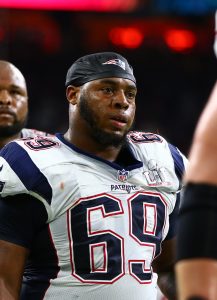 The Patriots did a favor for former quarterback Tom Brady when they shipped one of their most veteran blockers in Shaq Mason to Tampa Bay. It was a bit of a surprising move from New England’s perspective. The guard has been a consistent starter since being selected in the fourth round of the 2015 draft, and he hasn’t show any signs of slowing down despite appearing in 103 regular season games and another 13 postseason contests. In 2021, Pro Football Focus ranked Mason fourth among 82 eligible guards.
The Patriots did a favor for former quarterback Tom Brady when they shipped one of their most veteran blockers in Shaq Mason to Tampa Bay. It was a bit of a surprising move from New England’s perspective. The guard has been a consistent starter since being selected in the fourth round of the 2015 draft, and he hasn’t show any signs of slowing down despite appearing in 103 regular season games and another 13 postseason contests. In 2021, Pro Football Focus ranked Mason fourth among 82 eligible guards.
The addition of rookie Cole Strange removes some of the sting from Mason’s departure, and the Patriots still have a formidable starting offensive line. It’s the depth behind the five starters that’s questionable, and keeping Mason around certainly would have helped in the regard.
Although you would have had to squint, there was one point of time where you could have envisioned a Patriots offense guided by Jarrett Stidham and N’Keal Harry. Fast forward to this offseason, and the Patriots bailed on both players for a minimal return.
Stidham was selected in the fourth-round of the 2019 draft, and following a rookie season where he sat behind Brady, he would have had a chance to secure the starting gig in 2020. It was clearly troubling for Stidham’s future prospects when the Patriots pivoted to veteran Cam Newton, and it was clear that the young QB had no future in New England when the organization selected Jones in the first round of the 2021 draft. Fortunately for the Patriots, they found a taker in the Raiders and McDaniels.
There were even higher expectations for Harry when the receiver was selected in the first round of the 2019 draft. He was never able to click with Brady, and while he saw an increased role in 2020, he still finished with only 309 receiving yards. Following the Patriots’ spending spree during the 2021 offseason, Harry was buried on the depth chart and asked out of New England. It took a year, but he was granted his wish this offseason when he was traded to Chicago for a seventh-round pick.
Notable signings:
The Patriots broke records in 2021 when they committed $163MM in guaranteed money to free agent acquisitions. The front office had to tighten the belt straps in 2022, leading to a lack of big, multi-year, headline-stealing moves.
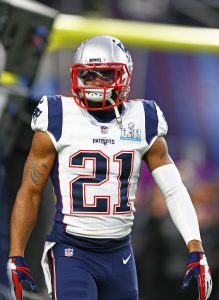 To help replace the departed J.C. Jackson, the Patriots brought back former Super Bowl hero Malcolm Butler to presumably start at cornerback. Butler’s exit from New England (which started with a practical DNP in Super Bowl LII) was a bit messy, but he’ll now be relied on to provide some experience to their cornerbacks corps. The 32-year-old didn’t play at all during the 2021 season, but he collected a career-high 100 tackles in 16 starts with the Titans in 2020.
To help replace the departed J.C. Jackson, the Patriots brought back former Super Bowl hero Malcolm Butler to presumably start at cornerback. Butler’s exit from New England (which started with a practical DNP in Super Bowl LII) was a bit messy, but he’ll now be relied on to provide some experience to their cornerbacks corps. The 32-year-old didn’t play at all during the 2021 season, but he collected a career-high 100 tackles in 16 starts with the Titans in 2020.
Mitchell was also added to provide some experienced depth at cornerback. The 30-year-old profiles as more of a rotational piece, but he could even find himself starting depending on the status of rookie Jack Jones and veteran Jalen Mills’ ability to bounce back from a rough season in 2021.
Perhaps the Patriots’ most intriguing addition was Jabrill Peppers. The safety was limited to only six games (five starts) in 2021 thanks to a torn ACL, and he’s never really lived up to his first-round pedigree. The Patriots have some solid depth already at safety in Devin McCourty, Kyle Dugger, and Adrian Phillips. However, Peppers has proved to be effective in defending the run, and he could find himself playing the pseudo-linebacker role that Patrick Chung used to play.
The Patriots added to their pass-catching corps with the additions of Ty Montgomery and Lil’Jordan Humphrey. Neither player moves the needle all that much, but there’s a world where they find themselves with a role in 2022. Montgomery has seen plenty of rushing opportunities since entering the NFL, and we could see the team fully commit to the veteran in the backfield similar to what they did with Cordarrelle Patterson in 2018. At the very least, Montgomery could see some third-down opportunities, especially considering the health of James White.
Read more
Notable losses:
Considering their penchant for letting cornerbacks walk, it always seemed unlikely that the Patriots would pony up to retain J.C. Jackson. The cornerback has snagged an NFL-leading 25 interceptions over the past four seasons, and he earned his first Pro Bowl nod in 2021 after leading the NFL with 23 pass breakups. The Patriots made an effort to extend Jackson during the 2021 campaign, but the player decided to play out the season. The writing was on the wall when New England didn’t slap Jackson with the franchise tag, and he ended up taking a lucrative pay day from Los Angeles.
 The Patriots have some questionable depth at cornerback heading into the season, with Butler and Mills leading the way. Bill Belichick and co. have had success finding cornerbacks in the draft and UDFA, adding some intrigue to fourth-round rookie Jack Jones (as well as third-round nickelback Marcus Jones). Still, there’s no denying Jackson’s importance in the secondary, and the Patriots inability to fill his spot will certainly show at some points during the upcoming campaign.
The Patriots have some questionable depth at cornerback heading into the season, with Butler and Mills leading the way. Bill Belichick and co. have had success finding cornerbacks in the draft and UDFA, adding some intrigue to fourth-round rookie Jack Jones (as well as third-round nickelback Marcus Jones). Still, there’s no denying Jackson’s importance in the secondary, and the Patriots inability to fill his spot will certainly show at some points during the upcoming campaign.
Otherwise, the Patriots didn’t lose any significant players this offseason. Brandon Bolden was a mainstay on special teams, and he had a career year on offense in 2021. However, considering the Patriots’ depth at RB, it was unlikely he’d continue to see an offensive role, and he ultimately joined McDaniels in Las Vegas. The same goes for Jakob Johnson, who also signed with the Raiders. Johnson told reporters earlier this offseason that the Patriots were planning to go away from the FB position in 2022.
Following a one-year stint in Miami, Kyle Van Noy rejoined the Patriots for the 2021 campaign. He ended up seeing time in 16 games (eight starts), collecting 66 tackles and five sacks. Ted Karras also returned to New England following a single season in Miami. He started 13 of his 17 appearances for New England last season.
Re-signed:
- Devin McCourty, S. One year, $9MM. $8MM guaranteed.
- Trent Brown, OT. Two years, $13MM. $4MM guaranteed.
- Brian Hoyer, QB. Two years, $4MM. $3MM guaranteed.
- Matthew Slater, WR/ST. One year, $2.62MM. $2.62MM guaranteed.
- Nick Folk, K. Two years, $5MM. $2.19MM guaranteed.
- James White, RB. Two years, $5MM. $500K guaranteed.
- Jakobi Meyers, WR (second-round RFA tender)
The Patriots spent the majority of their cap space on retaining free agent veterans. Fortunately, thanks in part to the players’ long tenures with the organization (coupled with the players’ declining on-field production), it didn’t break the bank to bring the veterans back.
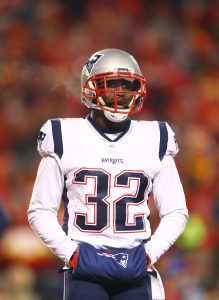 McCourty has been a mainstay on the Patriots defense since being selected in the first round of the 2010 draft, earning three Super Bowl rings and three second-team All-Pro nods. Despite the 2021 campaign being McCourty’s age-34 season, he still managed to rank 14th among eligible safeties in Pro Football Focus’ ranking of the position. While safety is one of the Patriots’ deepest position, they weren’t going to deny McCourty’s return.
McCourty has been a mainstay on the Patriots defense since being selected in the first round of the 2010 draft, earning three Super Bowl rings and three second-team All-Pro nods. Despite the 2021 campaign being McCourty’s age-34 season, he still managed to rank 14th among eligible safeties in Pro Football Focus’ ranking of the position. While safety is one of the Patriots’ deepest position, they weren’t going to deny McCourty’s return.
Trent Brown returned to New England for the 2021 campaign and had a bounceback season. While he only ranked 33rd among 83 eligible tackles via PFF, he still earned his highest grade and ranking since the 2018 campaign. Jakobi Meyers, a former UDFA, inked his second-round tender with the Patriots, keeping him in New England through at least the 2022 campaign. The receiver took another step forward in 2021, finishing with 83 receptions for 866 yards and two touchdowns.
For White and Matthew Slater, their value in the locker room likely supersedes their value on the field at this point. White continues to deal with a hip injury that limited him during the 2021 season, and there’s a chance he starts the season on the PUP. Slater is a long-time special teams ace who will have a consistent role as long as he wants to play. Nick Folk and Brian Hoyer could see some competition for their roles after reupping with the Patriots; the team recently brought in Tristan Vizcaino to get some reps at kicker, while rookie QB Bailey Zappe was selected in the fourth round.
Draft picks:
- 1-29: Cole Strange, G (UT-Chattanooga)
- 2-50: Tyquan Thornton, WR (Baylor)
- 3-85: Marcus Jones, CB (Houston)
- 4-121: Jack Jones, CB (Arizona State)
- 4-127: Pierre Strong, RB (South Dakota State)
- 4-137: Bailey Zappe, QB (Western Kentucky)
- 6-183: Kevin Harris, RB (South Carolina)
- 6-200: Sam Roberts, DT (Northwest Missouri State)
- 6-210: Chasen Hines, C (LSU)
- 7-245: Andrew Stueber, OG (Michigan)
The Patriots have never given a damn about mock drafts, and that was abundantly clear when they went way off the board to select Chattanooga offensive guard Cole Strange with their first-round pick. The move was met with some raised eyebrows; even the Rams publicly laughed at the selection. It’s hard to be overly critical of Bill Belichick, although the organization doesn’t have the best recent track record in the draft.
The selection is somewhat reminiscent of New England’s selection of Logan Mankins, but the Patriots would be thrilled if Strange was able to achieve even part of Mankins’ resume. The team better hope they hit on Strange in the first round, as the team lacks depth behind their starting five linemen.
The Patriots also went a bit off the board when they selected Baylor receiver Tyquan Thornton in the second round. Thornton was considered one of the fastest prospects in the draft, but he was still selected a few rounds earlier than expected. It’s hard to see the rookie cracking the top-four on the WR depth chart, and while he could theoretically be a special teams talent, he only had eight kick returns in four seasons at Baylor.
The Patriots used a pair of middle-round picks on cornerbacks Jack Jones (fourth round) and Marcus Jones (third round). The former earned strong reviews during minicamp, with some pundits wondering if he could supplant Mills as a starter on the outside. Meanwhile, the other Jones could see playing time as a nickelback, although it’ll be tough to beat out Jonathan Jones for the full-time role. At the very least, the rookie’s speed means he should play a role on special teams, potentially in the return game.
Pierre Strong Jr. is also an option to contribute in the return game. Considering the Patriots’ RB depth and the organization’s track record for redshirting rookie backs, there’s a good chance the South Dakota State product doesn’t see much of a role on offense in 2022. The same naturally goes for another fourth rounder. An old adage says you can never have too many good quarterbacks, but you’ve got to wonder if the Patriots could have gotten better value out of a fourth-round pick, especially after using a first-round selection at the position the year before. At the very least, Zappe should settle in as QB3 for the 2022 campaign, and he could eventually supplant Hoyer as Jones’ primary backup.
Other:
The Patriots haven’t had a listed defensive coordinator since Matt Patricia in 2017, with linebackers coaches Jerod Mayo and Steve Belichick most recently taking the non-official roles as co-DCs. With McDaniels off to Las Vegas, the Patriots will now try this recipe on offense.
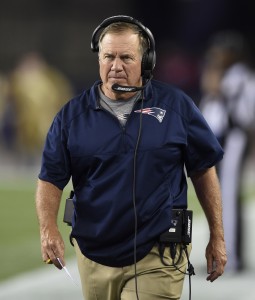 The thing is, the Patriots won’t be relying on offensive coaches to, you know, lead their offense. After spending the 2021 campaign in an unspecified role, Patricia is back on the sideline coaching…the offensive line. Meanwhile, former Patriots special teams coordinator Joe Judge is back in New England coaching…the quarterbacks.
The thing is, the Patriots won’t be relying on offensive coaches to, you know, lead their offense. After spending the 2021 campaign in an unspecified role, Patricia is back on the sideline coaching…the offensive line. Meanwhile, former Patriots special teams coordinator Joe Judge is back in New England coaching…the quarterbacks.
It’s a curious, borderline-unprecedented move to go with this arrangement. Some reporters have described Patricia as the “running game coordinator” and Judge as the “passing game coordinator,” but the Patriots surely won’t have the two alternating play-calling duties. Even if it’s Belichick pulling the strings on offense, you’d be right to question if the organization is putting Jones in a position to succeed heading into a crucial sophomore season.
Top 10 cap charges for 2022:
- Matt Judon, LB: $16.5MM
- Hunter Henry, TE: $15MM
- Nelson Agholor, WR: $14.8MM
- Jonnu Smith, TE: $13.6MM
- Isaiah Wynn, OT: $10.4MM
- Davon Godchaux, DT: $10.2MM
- Jonathan Jones, CB: $7.7MM
- Kendrick Bourne, WR: $6.4MM
- Jalen Mills, CB: $6.0MM
- DeVante Parker, WR: $6.0MM
Following the Patriots 2021 offseason spending spree, it’s no surprise that seven of those free agent acquisitions crack the team’s top-1o cap charges for the 2022 campaign. Isaiah Wynn is playing on his fifth-year option in 2022, while Jones was extended back in 2019. Parker is still playing on a four-year, $40MM pact he signed with the Dolphins in 2019. The Patriots will be in a position to spend again next offseason; Sportac estimates that the organization will have the third-most cap space in the NFL (behind the Bears and Seahawks).
While the loss of Jackson will undoubtedly hurt the Patriots secondary, Belichick will return much of the same team in 2022. New England went 10-7 in 2021, and with continuity on both the offensive and defensive side of the ball, it’d be reasonable to expect another step forward in 2022. That probably won’t be the case. A number of AFC teams improved this offseason, and while New England can count on some internal improvement, they undoubtedly got lapped by at least a few squads. Plus, as we mentioned multiple times, the organization hasn’t put their most important piece in a position to succeed. It’s hard to be overly critical of the team’s lack of spending or big-name acquisitions; that was never really in the cards following the 2021 offseason. Still, it’s hard not to raise an eyebrow at the team’s coaching decisions, and this could all lead to a disappointing season for Jones and the Patriots in 2022.
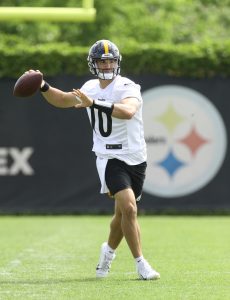 As apparent as Roethlisberger’s decline became, the Steelers likely will open the season with one of the NFL’s worst starting quarterbacks. QBR did slot Trubisky’s 2020 season ahead of even Roethlisberger’s — which featured 33 touchdown passes for a team with a last-ranked rushing attack — but the former one-year North Carolina starter has submitted an extensive run of mediocre NFL play. The Steelers do have a more well-rounded receiver stable compared to Trubisky’s Chicago troops, a largely Allen Robinson-dependent operation, and, likely, a superior running back. Perhaps with better tools, the 2017 No. 2 overall pick can make stabs at further rebuilding his stock.
As apparent as Roethlisberger’s decline became, the Steelers likely will open the season with one of the NFL’s worst starting quarterbacks. QBR did slot Trubisky’s 2020 season ahead of even Roethlisberger’s — which featured 33 touchdown passes for a team with a last-ranked rushing attack — but the former one-year North Carolina starter has submitted an extensive run of mediocre NFL play. The Steelers do have a more well-rounded receiver stable compared to Trubisky’s Chicago troops, a largely Allen Robinson-dependent operation, and, likely, a superior running back. Perhaps with better tools, the 2017 No. 2 overall pick can make stabs at further rebuilding his stock.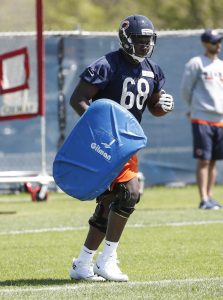 Trubisky invites obvious questions about Pittsburgh’s viability, but he should be protected better than Roethlisberger was in his finale. The team’s top O-line addition, Daniels will not turn 25 until mid-September. Pro Football Focus graded the former Bears second-round pick as a top-25 guard in each of his three full seasons as a starter. This type of player is not usually available for less than $9MM guaranteed, which points to front offices being less sold on the Iowa alum’s skills compared to PFF. But Daniels is the kind of player to bet on — one just coming into his prime — and the Steelers have him on barely a top-15 guard contract through 2024.
Trubisky invites obvious questions about Pittsburgh’s viability, but he should be protected better than Roethlisberger was in his finale. The team’s top O-line addition, Daniels will not turn 25 until mid-September. Pro Football Focus graded the former Bears second-round pick as a top-25 guard in each of his three full seasons as a starter. This type of player is not usually available for less than $9MM guaranteed, which points to front offices being less sold on the Iowa alum’s skills compared to PFF. But Daniels is the kind of player to bet on — one just coming into his prime — and the Steelers have him on barely a top-15 guard contract through 2024.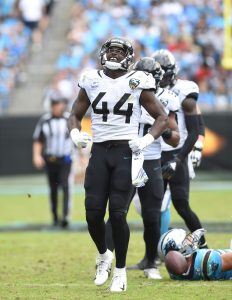 As could be expected, based on how the Steelers built their 2021 O-line, PFF graded the quintet 26th last season. Big Ben took 38 sacks — his most since 2013 — and Najee Harris managed only 3.9 yards per carry. It would be nice if the Steelers had elite O-line coach Mike Munchak back to help make these mid-tier contracts sparkle, but the team made some cost-efficient enhancements up front. It remains to be seen if they will be drastic improvements or patch jobs.
As could be expected, based on how the Steelers built their 2021 O-line, PFF graded the quintet 26th last season. Big Ben took 38 sacks — his most since 2013 — and Najee Harris managed only 3.9 yards per carry. It would be nice if the Steelers had elite O-line coach Mike Munchak back to help make these mid-tier contracts sparkle, but the team made some cost-efficient enhancements up front. It remains to be seen if they will be drastic improvements or patch jobs.